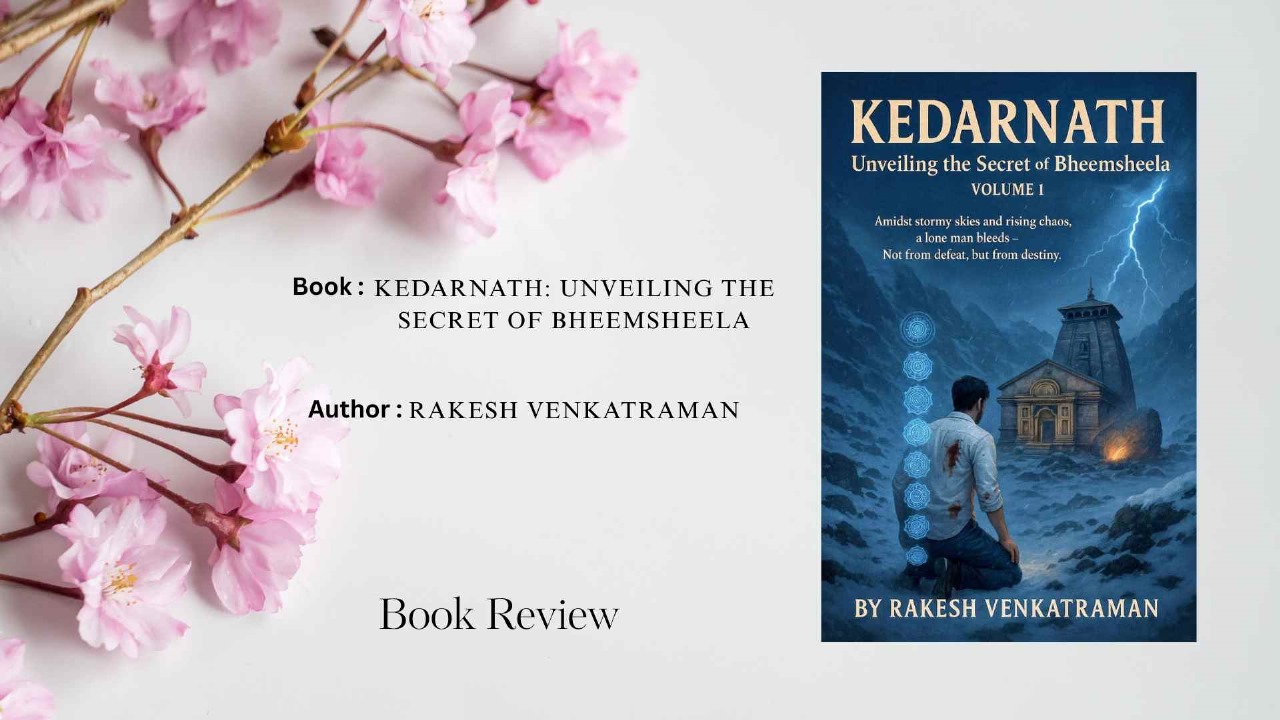Book Review: Kedarnath: Unveiling the Secret of Bheemsheela by Rakesh Venkatraman
Kedarnath: Unveiling the Secret of Bheemsheela by Rakesh Venkatraman is a rare kind of spiritual thriller that fuses myth, philosophy, and adventure into a single narrative tapestry. At its heart, it is the story of Rohan Desai, an ordinary man from Mumbai caught in the suffocating monotony of corporate life, whose life takes an unimaginable turn when destiny pulls him into a journey that bridges the visible and the unseen. The novel begins with a carefully crafted mundanity—Rohan’s routine, his cubicle, and the sense of emptiness that gnaws at his existence. This realistic opening becomes the canvas against which the extraordinary slowly emerges, making the reader feel the transformation not just as a fictional event but as a mirror to their own inner longings. Rohan’s path is not a straightforward hero’s journey; it is a series of inner and outer battles, encounters with guardians, and revelations of his own strength, weakness, and hidden depths. As he traverses from Mumbai to Varanasi, and finally to the spiritually charged landscapes tied to Kedarnath and the Jyotirlingas, the novel transcends the boundaries of geography and time, guiding the reader through an exploration of India’s mythic memory.
The plot revolves around the mystical secret of Bheemsheela, a stone tied to cosmic balance, but the deeper narrative is about the chakras—each trial Rohan faces is not just an external challenge but a reflection of his own psyche. The story blends seamlessly the concept of energy centers with physical trials, making the esoteric accessible through vivid imagery and thrilling action. Readers are taken from the Muladhara’s grounding lessons to the heights of Ajna and Sahasrara, where illusions dissolve into higher wisdom. This chakra-structured narrative is daring and ambitious, giving the novel a layered depth. On one level, it reads like an action-packed thriller with temples, floods, ancient glyphs, and prophecies, but on another, it feels like a guide for inner awakening, compelling the reader to ask: what fears, doubts, and illusions do we each need to face?
One of the strongest elements of the novel is its characterization. Rohan begins as an everyman—overworked, detached, and drifting—but his vulnerability makes his transformation relatable. His growth is not sudden; it is filled with resistance, denial, and pain. Alongside him, Priya, Maya, and Arjun are not mere side characters but pillars of the story, each representing knowledge, love, or strength. Priya, in particular, adds an emotional and spiritual anchor—her unconditional love becomes the key that draws divine intervention. There is a striking scene where Krishna himself appears to Rohan, gently reminding him: “Tumne Shiv ko nahi paaya. Woh tumhe paane aaye the. Kyunki tumhare dar ke neeche… samarpan tha.” Lines like these blur the boundary between myth and contemporary struggles, reminding readers that divinity is not something we chase externally but something that finds us when we are vulnerable, broken, and ready.
Venkatraman’s writing is cinematic and atmospheric, with immersive soundscapes and sensory detail. One can almost hear the temple bells, feel the icy floods of Kedarnath, or breathe in the smoke of incense as ancient rituals unfold. His interweaving of dialogues, chants, and scriptural echoes enriches the narrative with authenticity and reverence. At the same time, the story is modern, written in a Hinglish style that makes the philosophy approachable to younger readers without losing its gravitas. There are scenes of confrontation with Kaala, the embodiment of darkness, which are not just battles against an antagonist but symbolic of battling one’s own shadow self. Such symbolic layering elevates the novel beyond the ordinary thriller—it becomes a meditation on fear, memory, love, and dharma.
Another remarkable strength lies in how the author integrates Indian cultural and mythological elements without making them feel like exposition. The Jyotirlingas are not just religious symbols here but cosmic gates that safeguard the earth. The floods of Kedarnath are not mere natural disasters but metaphors for suppressed energies rising. Even Dwarka and Rameshwaram appear not just as locations but as living testaments to memory, devotion, and sacrifice. Through these, the book connects India’s living spiritual heritage with a futuristic and almost fantasy-like tone, making it appealing both to believers in tradition and seekers of new-age mysticism.
What makes Kedarnath: Unveiling the Secret of Bheemsheela compelling is its balance. It never allows philosophy to drown the thrill, nor lets action overshadow its reflective depth. Each chapter is paced to hold attention, yet it always leaves the reader with a lingering question or thought. The climax, which circles back to Bheemsheela, is not a simple resolution but an opening—reminding us that journeys of the spirit are never final, they are cycles of remembrance and awakening. The epilogues carry prophetic weight, showing the cost of battles, the fragility of memory, and the perseverance of dharma.
As a reviewer, one cannot help but note that this book is more than just a novel—it is a conversation with the reader’s own inner restlessness. It does not merely tell a story of Rohan; it asks every reader: what is your Bheemsheela, what fear are you avoiding, and what truth must you remember? The audiobook format, with its dramatized narration, only heightens this immersive quality, making it feel as if one is part of a grand cosmic drama unfolding in real time.
In conclusion, Rakesh Venkatraman has crafted a modern epic that speaks to both the rational mind and the searching soul. It is rooted in Hindu mythology yet daringly contemporary, weaving suspense, action, and philosophy into a coherent whole. For those seeking a fast-paced read, it offers a gripping story filled with floods, prophecies, and divine interventions. For those seeking reflection, it offers timeless wisdom hidden in dialogues with Krishna, in Rohan’s silent tears, or in Priya’s quiet devotion. Kedarnath: Unveiling the Secret of Bheemsheela is not just a thriller—it is a mirror, a pilgrimage, and a reminder that the greatest battles are fought within. This is a book that lingers long after the last page, urging readers to look inward, to remember, and to rise.
Author Feature: Rakesh Venkatraman




